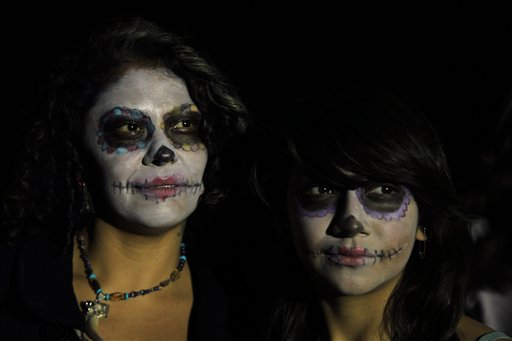 Women with their faces painted as a traditional Mexican "Catrina" pose during Day of the Dead celebrations at Mexico's National Autonomous University in Mexico City, Wednesday, Oct. 30, 2013. Known as the "Catrina," the figure of a skeleton wearing an elegant broad-brimmed hat was first done as a satirical engraving by artist Jose Guadalupe Posada somewhere between 1910 and his death on Jan. 20, 1913.
Women with their faces painted as a traditional Mexican "Catrina" pose during Day of the Dead celebrations at Mexico's National Autonomous University in Mexico City, Wednesday, Oct. 30, 2013. Known as the "Catrina," the figure of a skeleton wearing an elegant broad-brimmed hat was first done as a satirical engraving by artist Jose Guadalupe Posada somewhere between 1910 and his death on Jan. 20, 1913.MEXICO CITY - Mexico's elegant and classy "Skeleton Lady" is getting new attention more than a century after she was born, inspiring some movie and rock stars in the U.S. to don Halloween costumes based on the macabre figure that has grown to symbolize the Day of the Dead.
As Mexico's capital marks the 100th anniversary of the death of the artist who created "Catrina," dozens of video bloggers are offering tips on how to nail her pale skull look.
Jose Guadalupe Posada, the cartoonist who created Catrina, is being honored by Mexico City with giant replicas of his illustrations and a display of skeleton statues for the Day of the Dead offering that opens on the capital's main plaza Thursday. Such offerings traditionally consist of an altar with flowers, food and a photo of a departed loved one.
The Skeleton Lady in her elegant broad-brimmed hat first appeared in a satirical engraving that Posada did sometime between 1910 and his death on Jan. 20, 1913. He wanted to mock those who pretended to be of a higher class, even if it meant starving, and going painfully thin, or without flesh. She became the most famous of Posada's illustrations, with later sketches dressing her in classy Victorian-era garments with a high neckline.
As Halloween celebrations make inroads in Mexico, the spooky and sexy Catrina look is spreading a Mexican touch to the north. Singer Fergie of the Black Eyed Peas sported a sexy Catrina outfit with a red-and-black shawl and headpiece and published a photo on her Instagram account. Sandra Bullock was caught by photographers in Los Angeles wearing Mexican-style skull makeup and a black dress.
While it's often called "Mexican Candy Skull" makeup, the Catrina touches of elegant scarves and veiled hats stem from the Skeleton Lady. Dozens of tutorials popped up in the last month on YouTube showing how to darken circles around the eyes and draw colorful shapes on the cheeks to create a frightening, yet festive look.
At some online costume stores in the Unites States, short-skirted and tight-bodiced "muerta" or "sugar-skull" costumes are on sale.
The Catrina is also trendy among young women in Mexico. Makeup studios and salons apply the complex face paint for as much as 1,000 pesos (about $80) for Halloween as Mexicans increasingly mix the U.S. festival with the Day of the Dead, which traditionally didn't involve dressing up.
For Andrew Chesnut, author of "Devoted to Death: Santa Muerte, the Skeleton Saint" and a professor of Catholic Studies at Virginia Commonwealth University, the Catrina's rise in the U.S. is part of the increasing Mexican and Latin American influence in the United States.
"She is kind of a perfect example of integrating both traditions and not seeing any contradiction or problems with that," Chesnut said. He said more and more U.S. families, not only of Mexican descent, are setting up altars and celebrating Day of the Dead.
The Catrina went through a couple of incarnations before becoming a scary sex symbol.
Posada created her to poke fun at "people who pretended to be European, but weren't," said Mercedes Sierra, a visual arts professor at Mexico's National Autonomous University.
Most Mexicans are of Indian descent, but given long-standing racism, many tried to look European with their clothing or makeup. So Posada created the elegantly dressed skeleton - "skeleton" being Mexican slang for someone so poor they couldn't eat.
Even though he mocked people with pretentions, Posada said that drawing her as a skeleton was also a way to reject social stratification.
"Death is democratic. At the end, regardless of whether you are white, dark, rich or poor, we all end up as skeletons," Posada said at the time.
In the mid-1940s, Mexican artist Diego Rivera put Posada and the Skeleton Lady in the central position of his mural "Dream of a Sunday Afternoon in the Alameda Central," which depicted iconic figures from Mexican arts and history.
It was Rivera who gave the figure the name "Catrina," Sierra said.
